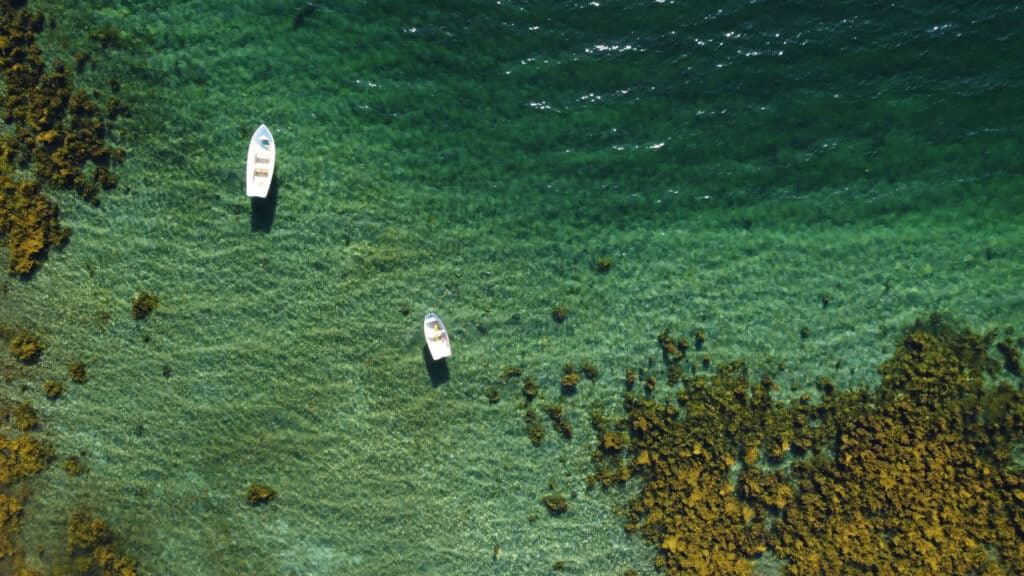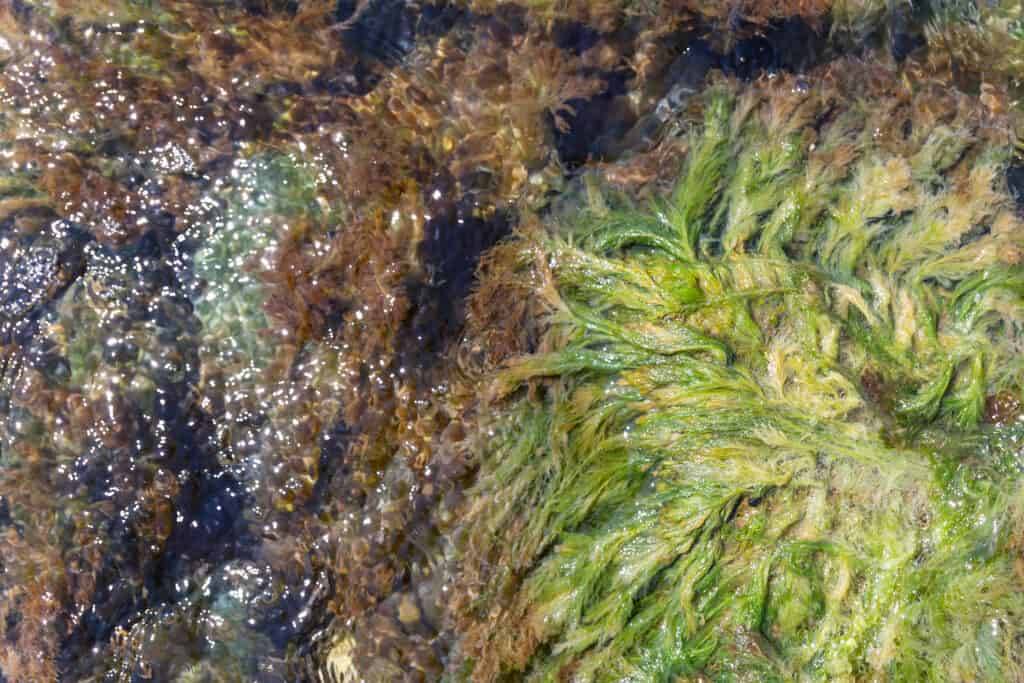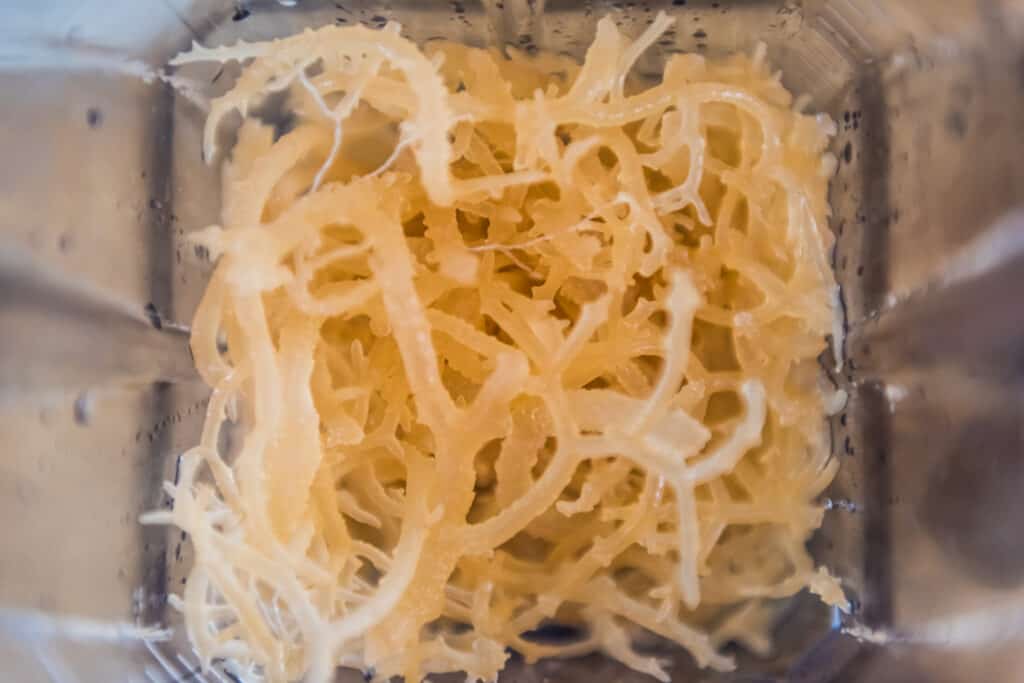Irish sea moss is a term that can refer to two vastly different plants. The term is frequently used interchangeably to refer to either a species of red algae, Chondrus crispus, or a species in the genus Gracilaria. However, these two varieties of moss are actually different, so it’s worth exploring the ways in which they are similar and how they differ.
Both Chondrus crispus and Gracilaria are red algae (singular, alga) that grow on ocean coastlines and often attach to rocks. Yet the similarities don’t stop there. Gracilaria, also known as purple sea moss or Jamaican sea moss, and Chondrus crispus, the original Irish sea moss, have a lot in common. Here are some of the other ways in which they are similar:
- Both grow in the middle intertidal zone down to the subtidal zone
- Both are eaten as a superfood and used as an ingredient that serves as a thickening agent in foods like ice cream and pudding
- Both are often red or purple in color, but come in varying hues that also include shades of yellow, brown, and green
However, there are also several ways in which Gracilaria and Chondrus crispus are very different. Let’s explore some of those differences together! We will cover where each type of red algae grows, their growing conditions, appearance, and history. Let’s go!
Comparing Purple Sea Moss and Irish Sea Moss
| Characteristic | Purple Sea Moss | Irish Sea Moss |
|---|---|---|
| Scientific Name | There are many different species of Gracilaria commonly referred to as “purple sea moss.” | Chondrus crispus |
| Genus | Gracilaria | Chondrus |
| Family | Gracilariaceae | Gigartinaceae |
| Division | Rhodophyta | Rhodophyta |
| Common Name | Purple sea moss, Jamaican sea moss, red seaweed, Irish moss | Irish moss, carrageen moss |
| Origin | Gracilaria may be found in oceans across the world on the coastlines of every continent except for Antarctica. | Chondrus crispus grows in the Atlantic Ocean on the coastlines of Europe and North America |
| Description of Plant | Gracilaria includes diverse species which grow in shades of red, purple, and greenish yellow. | Chondrus crispus is a red algae species, which varies in color from green-yellow to red or dark purple. |
| Growing Conditions | Gracilaria is a genus with species that grow across the world, but typically in warmer waters. This article examines the multiple species of Gracilaria that grow in the Caribbean, particularly around the island of Jamaica. These species thrive in tidal pools, bays, and estuaries, in warm and relatively calm water. | Chondrus crispus grows along the rocky coastline of the Atlantic Ocean. It can survive with very little sunlight and grows many meters deep in cold water. |
| Growing Zones | Middle intertidal zone to shallow subtidal zone | Middle intertidal zone to the subtidal zone |
Overview
It is important to note that neither purple sea moss nor Irish sea moss may actually be moss. In fact, the term moss encompasses more than 12,000 species of plants that grow on land. Rather, what is often referred to as sea moss or seaweed is typically algae. More specifically, purple sea moss and Irish sea moss are types of red algae. There are more than 7,000 different species red algae, or Rhodophyta
Rhodophyta have played an important role in human development, and more research is emerging that shows their value in the human diet. Red algae species are a rich source of protein, polyunsaturated fatty acids, vitamins, and minerals. Research suggests that these nutrients can play a role in the treatment of cancer and inflammatory diseases, as well as giving a boost to otherwise healthy individuals. As a result, eating red algae has become very popular in recent years, making it possible to find many varieties in local grocery stores and online.

Purple sea moss and Irish sea moss are types of red algae.
©iStock.com/wirestock
Purple Sea Moss
Purple sea moss can describe several different plants, but our focus will be on the red algae genus of Gracilaria. Gracilaria represents 100-200 different species, several of which can be found growing in the Caribbean. Known as Irish sea moss or Jamaican sea moss, the different Gracilaria species grow in warm waters across the world and have long been an important source of gelatin. Though they vary in color depending on the species, they tend to be green, red, purple, and even yellow.
Irish Sea Moss
The plant originally known as Irish sea moss is also red algae. More specifically, Irish sea moss is the colloquial name for Chondrus crispus, a species in the Chondrus genus, which includes 10 other species. Chondrus crispus grows in colder water than Gracilaria and can be found along the coastlines of North America and Europe, in countries like Canada, Ireland, and the United States. Though Chondrus crispus also varies in color, it is most commonly a dark red or purple shade. It is small, only several inches long, and has a potent, distinctive smell that denotes its ocean origins.
Key Differences
Purple sea moss and Irish sea moss have a lot in common. Harvesting both types of red algae, for their culinary use and medicinal benefits has a long history.
Although they have similar colors, grow in similar aquatic climates, and are often harvested and consumed by humans, purple sea moss and Irish sea moss differ significantly in their histories, environments, and appearances.
History
As a plant genus with species that grow across the world, Gracilaria has a long history of being harvested and consumed by humans. It has been cultivated in open water, ponds, and tanks. Gracilaria is one of two genera, along with Gelidium, agar-containing seaweeds, or agarophytes. Graciliara has long been cultivated as a source of agar, which is used as a thickener in foods. In the Caribbean, it has long been sold as a sea moss, however, with the arrival of Irish immigrants it became known as Irish sea moss. Newcomers from Ireland brought their culinary traditions and experiences with Chondrus crispus to their new homeland, along with the traditional name Irish sea moss.
The original Irish sea moss, Chondrus crispus, has been harvested and consumed by people living on the British Isles for thousands of years. Historically, the plant has been used for both culinary and medicinal purposes. Traditionally, it was harvested to treat cold and flu symptoms, as well as to form the base for a substantive beverage. During the Irish Potato Famine in the 1800s, when people in Ireland were seeking alternative food sources, Chondrus crispus played an important role as a key ingredient in making a fortified beverage that was consumed by starving Irish people.
Historically, Chondrus crispus has played an important role as a key source of carrageenan and has been cultivated to be harvested to be used as a thickening agent in jelly, pudding, and ice cream
Appearance
Gracilaria, or purple sea moss, varies greatly in appearance depending on the species. However, in general, the species of Gracilaria that grow around the Jamaica and other Caribbean islands have a frond with flat and long branches. These may grow to be purple, red, or brown, or a paler yellow or gold color. They are also typically branching, bushy, and round, coming from a flat disc that originated from a spore. Each of the blades reproduces by making its their spores. The fronds are fragmented and grow in a tangle. They are narrow in width but can be as long as 18 or 20 inches in length. Gracilaria species frequently grow in clumps 10 or 11 inches wide.
In contrast, Chondrus crispus has multiple branches that are usually dark purple or red, though they can become translucent from intense sunlight. Chondrus crispus is smaller than Gracilaria, typically growing to be 6 to 8 inches long, with individual fan-like branches that are less than half an inch wide.

or purple sea moss, varies greatly in appearance depending on the species.
©iStock.com/Natalia Duryagina
Growing Conditions
Purple Sea Moss (Gracilaria)
Gracilaria grows all over the world, typically in warmer waters such as that found in parts of the Pacific Ocean in Asia or in the Caribbean. There are multiple species that are often interchangeably described as purple sea moss, Jamaican sea moss, or Irish sea moss, which grow around Jamaica. The species of Gracilaria that grow around the island of Jamaica and other Caribbean coasts thrive best in warm water between 75 degrees and 85 degrees Fahrenheit, though they are able to survive in cooler temperatures. Gracilaria species are most often found in shallow waters, such as that in bays, estuaries, and tidal pools. However, they may also float freely. It is also a euryhaline organism, meaning that the species in the Gracilaria genus will tolerate water with varying degrees of salinity.
Gracilaria species have a holdfast rather than a traditional root system. The entire plant body absorbs nutrients, so rather than serving as a conduit for nutrition, the holdfast serves to attach the plant to a rock or other object. Though Graciliara species grow natively across the world, certain types of Graciliara have been introduced to new environments where they grow as invasive species that cause damage to the native plant life. For example, certain Graciliara species currently grow off of the coast of Hawaii, where they are thriving on reefs while disrupting the ecosystem.
Irish Sea Moss (Chondrus crispus)
Chondrus crispus, or Irish sea moss, grows in the seas of the North Atlantic, along the coastlines of North America and Europe. Unlike Gracilaria, Chondrus crispus is native to the colder ocean climates. There it grows in the middle intertidal and subtidal zones. Though it most frequently grows between 10 and 20 feet deep, it can grow more than 100 feet below the water’s surface! It is resilient to changes in temperature, though it grows more rapidly in warmer water, with studies showing more rapid growth in 68 degrees Fahrenheit water than in water 60 degrees Fahrenheit and below.
Chondrus crispus grows on rocks and in rock pools, remaining small but surviving well in brackish water. Chondrus crispus may appear in a more pale color when exposed to intense sunlight.
Like those in the Gracilaria genus, Chondrus crispus also grows with a holdfast rather than a traditional root system. The size of the holdfast corresponds to the density and length of the algae fronds.
Uses
Both Gracilaria and Chondrus crispus have long been harvested wild and are now cultivated for human consumption. They are added to soups, salads, and other dishes. However, they are also particularly valuable and frequently used as an ingredient with thickening properties.
Gracilaria is a source of agar, which is a gelatinous substance of polysaccharides that is extracted from red algae. Agar is used to thicken desserts like ice cream and pudding, as well as savory soups and gravies. It is also commonly used in protein powders as a source of vegetable protein. Agar is a key component of cosmetic and personal hygiene products as a stabilizer.
Chondrus crispus is a source of carrageenan. Carrageenan, like agar, is an additive used in foods and drinks to thicken and preserve them. Also like agar, carrageenan can be used in ice cream and pudding. However, in addition to being found in dessert confections, it is also now an important ingredient in popular dairy alternative drinks like soy milk, almond milk, and coconut milk.

Agar, a component of red algae, is used to thicken desserts like ice cream and pudding, as well as savory soups and gravies.
©iStock.com/ablokhin
In addition to their thickening properties, both Gracilaria and Chondrus crispus have gained status as superfoods. Red algae species often have many nutrients that are purported to be a valuable source of minerals, fibers, and antioxidants. As a result, multiple varieties and flavors of red algae are now available at your local grocery. Red algae can be found in protein powders, snacks, and supplements. It can, however be confusing as both Gracilaria species and Chondrus crispus are marketed as Irish sea moss. Gracilaria, much more plentiful and easy to cultivate, is more widespread and more affordable. s a result, most retailers sell Gracilaria, though the label says Irish sea moss.
Presently red algae species are a focus of emerging medical research, as studies are showing that red algae has properties that could influence future drug developments and advancements in medical treatments.
This article compares two types of red algae, both of which have become popular foods. Both also have different characteristics that allow them both to serve as a thickening ingredient in many recipes. They are also sometimes known by the same name: “Irish sea moss.” As we have learned, neither should actually be called “moss.” Only Chondrus crispus has ever grown on the coast of Ireland. However, we do know that they have long been harvested by humans and likely will continue to be a staple ingredient. Historically considered to be a valuable treatment for illness, they may even take a bigger role in medicine as research reveals new uses.
The two have distinct growing environments, appearances, and histories. This sets them apart and makes each one interesting and unique in their own way.
Next Up
Thank you for reading! Have some feedback for us? Contact the AZ Animals editorial team.








